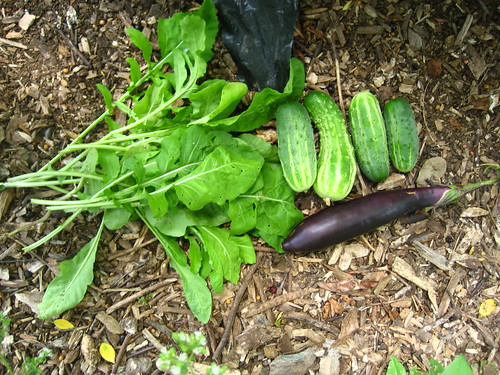I attended five workshops and two tours at the conference, all of which were led by fascinating and inspiring people from organizations all over the country. One organization really struck me though:
Local Matters - Columbus, OH
The organization Local Matters is an incredibly successful and influential non-profit collaboration of people who are working to educate the community about everything related to local food right there in Columbus, OH. It is run by a chef, an ecological garden designer, and food and community garden activists who all brought years of experience and passion to the collaboration. The organization consists of several programs:
Food to School - this program uses the "
Food is Elementary" curriculum to teach nutrition and healthy living to students from grades K-2. They also help schools develop and build
Outdoor Learning Environments on their grounds, which are outdoor classroom and garden spaces.
Urban Agriculture - this program focuses on cooking education, community gardening, and food access; their "veggie van" drives around selling fresh produce in neighborhoods with limited access to grocery stores.
Food to Fork - this program helps farmers create more business markets to sell their food. Local Matters in partnered with a for-profit store called the
Greener Grocer which they created to assist their organization in it's operations.
_____________________________
I went to a workshop led by the nutrition educators at Local Matters, and on a tour led by one of the Outdoor Learning Environment designers, which showcased four of their school gardens:
#1 - Lincoln Park Elementary SchoolThis garden is planted, tended, and harvested by the children with assistance from a local farmer who is paid by the school. During the school year it is tended by an after-school program called FAN (Fitness and Nutrition), and during the summer it is tended by parents and students in the area. The garden is planted in a circular design with kale, broccoli, cherry tomatoes, melons and more.

 #2 Early Childhood Education and Family Center
#2 Early Childhood Education and Family CenterThis is a large facility dedicated to the education of developmentally disabled children. There are several gardens located around the property, including this food and flower garden which is used to teach color recognition and light food preparation, and has terracotta columns for wheelchair accessibility.

This is called the Studio Garden and it has native plants, rock piles, work benches with garden tools, logs and sticks for building, and a music station.


At this site there is also a Farm Garden, which is planted and maintained by a local farmer.


The coolest part was this straw fort!
 #3 - Early Childhood Learning Community
#3 - Early Childhood Learning CommunityThis garden was my favorite. The staff at Local Matters got to build this garden from scratch, so they sat down with faculty, staff, students and parents at this facility (which is also dedicated to developmentally disabled students) and did a "
dreamstorming" to come up with the design. They thought about
their wants and needs for the garden, their childhood and their dreams. Through that they came up with the following amazing outdoor playground:

***metal sculptures for climbing with a bell at the top for ringing, designed by a local artist and surrounded by soft wood chips***

***A red mama monkey who is a meeting place and watches over the playground***

***tall grasses and flowers with paths to run through and play***

***Another metal sculpture for climbing and sitting, and hills and valleys to roll down***

***Sand area and water features that are turned on when the kids come to play***

***And a circular edible garden which will tie in to the "Food is Elementary" curriculum they will start to teach this year***
#4 Brookside Elementary SchoolThis is a unique public school where the principal is an engaged and committed member of the community (not that other principals are not committed and engaged, but this one is exceptionally so). His background is in ecology and there is a strong emphasis on outdoor learning and natural history. There is a pond on the property with bleacher seating for conducting classes, as well as two large butterfly gardens surrounding the school building. The school has decided to become a "Monarch butterfly school;" raising and releasing monarch butterflies during the school year and the summer. Local Matters helped them build the first phase of a two phase garden called the Three Sisters/Settlers Garden which demonstrates the gardening techniques of the Native Americans and the Settlers of that area of the country. The Native American garden is shaped like a turtle, one of the prevalent symbols of the tribes from that area.

All of the grades get a slice of the garden to tend, and there is a three sisters garden and a compost area in the garden as well.

___________________
To my eyes, Local Matters is a collaboration of many passionate and charismatic people who all brought their talents and
funders together to work as a team. And it's working, what a shock! I was clearly very impressed by the work they are doing and I think their model is a wonderful one that should be implemented all over the country.
Next up: More inspiring workshops from the conference!























































